On A Control Chart, What Separates Common From Assignable Causes Of Variation?
March 2016
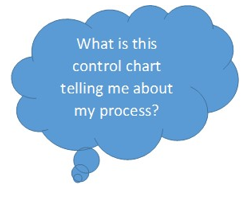 Command charts are a valuable tool for monitoring process operation. However, you have to be able to interpret the command chart for it to be of whatever value to you lot. Is communication important in your life? Of course it is – both at work and at home. Here is the primal to effectively using control charts – the control chart is the style the process communicates with you. Through the control chart, the process will let yous know if everything is "under control" or if there is a problem nowadays. Potential bug include big or small shifts, upward or downward trends, points alternating upwardly or downwards over time and the presence of mixtures.
Command charts are a valuable tool for monitoring process operation. However, you have to be able to interpret the command chart for it to be of whatever value to you lot. Is communication important in your life? Of course it is – both at work and at home. Here is the primal to effectively using control charts – the control chart is the style the process communicates with you. Through the control chart, the process will let yous know if everything is "under control" or if there is a problem nowadays. Potential bug include big or small shifts, upward or downward trends, points alternating upwardly or downwards over time and the presence of mixtures.
This month's publication examines 8 rules that you can apply to assistance yous interpret what your control chart is communicating to you. These rules assist you identify when the variation on your control chart is no longer random, merely forms a design that is described past 1 or more of these eight rules. These patterns give you insights into what may exist causing the "special causes" – the problem in your procedure.
In this issue:
- Variation Review
- Control Chart Review
- The eight Control Chart Rules
- Possible Causes past Pattern
- Summary
- Video: Interpreting Command Charts
- Quick Links
You may download a pdf copy of this publication at this link. You may also exit a annotate at the end of the publication.
Variation Review
Nosotros take covered variation in eleven publications over the years. Here is an excerpt from one:
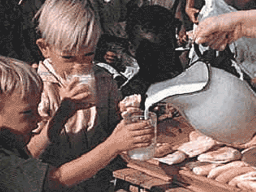 "I used to, now and and then, spill a glass of milk when I was young. Our table slanted toward where my mother saturday. And so, the milk always headed in her direction. And she unremarkably had some option words when this happened. Of form, I was at mistake. I needed to be more careful. Or was that really true? If you lot empathize variation, you will realize that virtually of the issues you face are not due to individual people, just to the process -- the mode it was designed and the style information technology is managed on a twenty-four hours-to-solar day basis.
"I used to, now and and then, spill a glass of milk when I was young. Our table slanted toward where my mother saturday. And so, the milk always headed in her direction. And she unremarkably had some option words when this happened. Of form, I was at mistake. I needed to be more careful. Or was that really true? If you lot empathize variation, you will realize that virtually of the issues you face are not due to individual people, just to the process -- the mode it was designed and the style information technology is managed on a twenty-four hours-to-solar day basis.
Variation comes from two sources, common and special causes. Recall about how long it takes y'all to get to work in the morning. Maybe it takes you lot 30 minutes on boilerplate. Some days it may have a little longer, some days a little shorter. But equally long equally y'all are within a certain range, y'all are not concerned. The range may be from 25 to 35 minutes. This variation represents mutual cause variation --- it is the variation that is always present in the process. And this type of variation is consistent and predictable. You don't know how long information technology will have to get to work tomorrow, but yous know that information technology will be betwixt 25 and 35 minutes as long equally the process remains the same.
Now, suppose you have a flat tire when driving to work. How long will it take yous to get to work? Definitely longer than the 25 to 35 minutes in your "normal" variation. Mayhap it takes you an hour longer. This is a special cause of variation. Something is different. Something happened that was non supposed to happen. Information technology is non role of the normal process. Special causes are not predictable and are sporadic in nature.
 Why is it important to know the blazon of variation nowadays in your process? Because the action yous take to meliorate your process depends on the type of variation present. If special causes are present, you must discover the crusade of the problem and so eliminate it from ever coming back, if possible. This is ordinarily the responsibility of the person closest to the procedure. If only common causes are present, yous must FUNDAMENTALLY change the process. The cardinal word is fundamentally -- a major modify in the process is required to reduce mutual causes of variation. And management is responsible for changing the process.
Why is it important to know the blazon of variation nowadays in your process? Because the action yous take to meliorate your process depends on the type of variation present. If special causes are present, you must discover the crusade of the problem and so eliminate it from ever coming back, if possible. This is ordinarily the responsibility of the person closest to the procedure. If only common causes are present, yous must FUNDAMENTALLY change the process. The cardinal word is fundamentally -- a major modify in the process is required to reduce mutual causes of variation. And management is responsible for changing the process.
Information technology has been estimated that 94% of the bug a company faces are due to common causes. Merely 6% are due to special causes (that may or may not be people related). So, if y'all ever blame problems on people, you will be incorrect at least 85% of the fourth dimension. It is the process most of the fourth dimension that needs to be changed. Management must set upwardly the system to allow the processes to be changed."
Control Chart Review
The only effective manner to separate common causes from special causes of variation is through the apply of command charts. A control nautical chart monitors a process variable over fourth dimension – eastward.g., the fourth dimension to get to work. The boilerplate is calculated after yous have sufficient information. The control limits are calculated – an upper control limit (UCL) and a lower command limit (LCL). The UCL is the largest value you lot would expect from a process with just mutual causes of variation present. The LCL is the smallest value yous would expect with only common cause of variation present. As long as the all the points are inside the limits and there are no patterns, only common causes of variation are present. The process is said to exist "in command."
 Figure 1 is an case of a command nautical chart using the driving to work example. Each day the time to get to work is measured. The data are and then plotted on the control chart. The average is calculated. The boilerplate is 26.two – which ways information technology takes on average each twenty-four hour period 26.2 minutes to get to work. The control limits are then calculated. The UCL is 41.9 minutes. This is the maximum time it volition have to get to piece of work when just common causes are present. The LCL is 10.vi minutes. This is the minimum fourth dimension it volition take to get to work when but common causes are present. As long as all the points are inside the control limits and in that location are no patterns, then process is in statistical command.
Figure 1 is an case of a command nautical chart using the driving to work example. Each day the time to get to work is measured. The data are and then plotted on the control chart. The average is calculated. The boilerplate is 26.two – which ways information technology takes on average each twenty-four hour period 26.2 minutes to get to work. The control limits are then calculated. The UCL is 41.9 minutes. This is the maximum time it volition have to get to piece of work when just common causes are present. The LCL is 10.vi minutes. This is the minimum fourth dimension it volition take to get to work when but common causes are present. As long as all the points are inside the control limits and in that location are no patterns, then process is in statistical command.
Effigy i: Control Chart Example
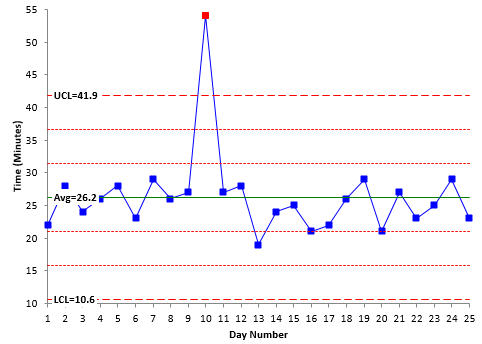
There is ane point beyond the UCL in Figure ane. This is the first pattern that signifies an out of control betoken – a special cause of variation. One possible cause is the flat tire. At that place are many other possible causes as well – car break downwards, bad atmospheric condition, etc.
 Special causes of variation are detected on command charts by noticing sure types of patterns that appear on the control chart. The betoken beyond the control limits is ane such blueprint. You might see a pattern of vii consecutive points above the average. This pattern indicates that something has happened to cause your process average go upward – a special cause is present. Recognizing patterns – and what they hateful in your process – is ane key to finding the reason for special causes. All of the control nautical chart rules are patterns that class on your control chart to bespeak special causes of variation are present.
Special causes of variation are detected on command charts by noticing sure types of patterns that appear on the control chart. The betoken beyond the control limits is ane such blueprint. You might see a pattern of vii consecutive points above the average. This pattern indicates that something has happened to cause your process average go upward – a special cause is present. Recognizing patterns – and what they hateful in your process – is ane key to finding the reason for special causes. All of the control nautical chart rules are patterns that class on your control chart to bespeak special causes of variation are present.
Some of these patterns depend on "zones" in a command chart. To see if these patterns exits, a control chart is divided into 3 equal zones above and below the boilerplate. This is shown in Figure 2.
Figure 2: Control Chart Divided into Zones
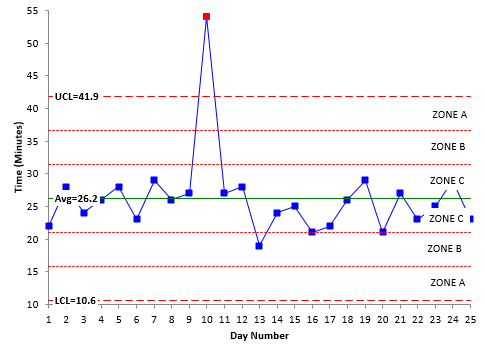
Zone C is the zone closest to the average. It represents the area from the boilerplate to one sigma higher up the average. There is a corresponding zone C beneath the average. Zone B is the zone from one sigma to two sigma above the average. Again, in that location is a corresponding Zone B below the boilerplate. Zone A is the zone from 2 sigma to three sigma above the boilerplate – besides as below the average.
The 8 Command Nautical chart Rules
If a process is in statistical control, most of the points will exist nearly the average, some will be closer to the command limits and no points will be beyond the control limits. The eight command chart rules listed in Tabular array 1 give y'all indications that there are special causes of variation present. Again, these stand for patterns.
Table 1: Control Chart Rules
| Rule | Rule Name | Blueprint |
| ane | Across Limits | One or more points beyond the command limits |
| two | Zone A | 2 out of 3 consecutive points in Zone A or beyond |
| iii | Zone B | 4 out of five sequent points in Zone B or beyond |
| 4 | Zone C | 7 or more sequent points on 1 side of the average (in Zone C or beyond) |
| 5 | Trend | 7 consecutive points trending up or trending downwardly |
| half-dozen | Mixture | eight consecutive points with no points in Zone C |
| 7 | Stratification | 15 consecutive points in Zone C |
| 8 | Over-control | 14 consecutive points alternate up and down |
It should exist noted that the numbers tin can be dissimilar depending upon the source. For example, some sources will employ viii consecutive points on one side of the average (Zone C test) instead of the 7 shown in the table higher up. Just they are all very similar. Figures 3 through 5 illustrate the patterns. Figure three shows the patterns for Rules one to 4.
Figure 3: Zone Tests (Rules ane to 4)
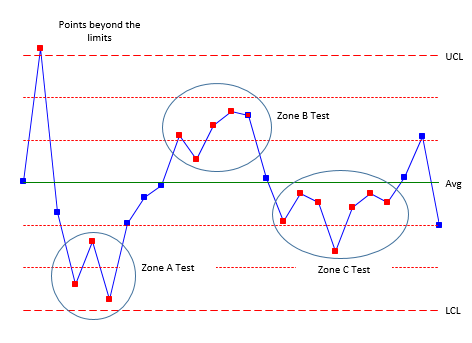
Rules ane (points beyond the command limits) and ii (zone A test) stand for sudden, large shifts from the boilerplate. These are oftentimes fleeting – a i-time occurrence of a special cause – like the apartment tire when driving to piece of work.
Rules 3 (zone B) and 4 (Zone C) represent smaller shifts that are maintained over fourth dimension. A modify in raw material could crusade these smaller shifts. The central is that the shifts are maintained over time – at least over a longer time frame than Rules 1 and 2.
Figure 4 shows Rules 5 and six. Rule 5 (trending upwards or trending down) represents a procedure that is trending in ane direction. For instance, tool wearing could cause this type of tendency. Rule 6 (mixture) occurs when yous have more than one process present and are sampling each procedure by itself. Hence the mixture term. For example, you lot might be taking data from four different shifts. Shifts 1 and 2 operate at a dissimilar average than shifts 3 and 4. The control nautical chart could have shifts 1 and ii in zone B or across above the average and shifts 3 and 4 in zone B below the average – with null in zone C.
Figure 4: Rules 5 and six
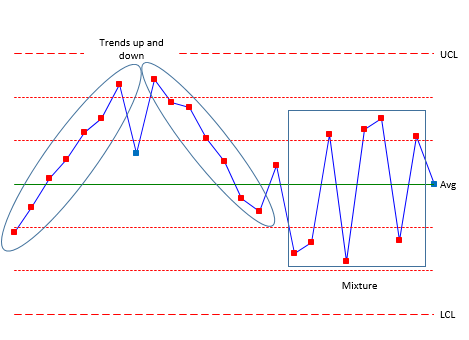
Figure five shows rules 7 and eight. Rule seven (stratification) also occurs when you have multiple processes but you are including all the processes in a subgroup. This can atomic number 82 to the information "hugging" the boilerplate – all the points in zone C with no points across zone C. Dominion 8 (over-control) is often due to over adjustment. This is oftentimes called "tampering" with the process. Adjusting a process that is in statistical control actually increases the process variation. For example, an operator is trying to hit a certain value. If the result is higher up that value, the operator makes an adjustment to lower the value. If the result is beneath that value, the operator makes an adjust to raise the value. This results in a saw-molar pattern.
Figure five: Rules seven and 8
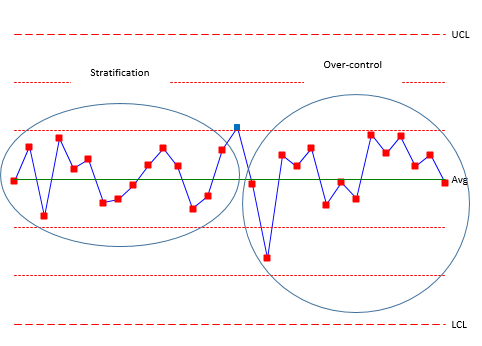
Rules 6 and 7, in detail, often occur because of the way the information are subgrouped. Rational subgrouping is an important part of setting upward an effective control chart. A previous publication demonstrates how mixture and stratification tin can occur based on the subgrouping selected.
These rules stand for unlike situations – patterns = on a control nautical chart. It should be noted that not all rules apply to all types of control charts. Tabular array 2 summaries the rules by the type of pattern.
Table two: Rules by Type of Pattern
| Pattern Clarification | Rules |
| Large shifts from the average | 1, 2 |
| Pocket-sized shifts from the average | three, 4 |
| Trends | 5 |
| Mixtures | vi |
| Stratifications | 7 |
| Over-control | 8 |
Possible Causes by Design
It is difficult to listing possible causes for each pattern because special causes (just like mutual causes) are very dependent on the type of process. Manufacturing processes accept different problems that service processes. Different types of control nautical chart wait at unlike sources of variation. Still, it is helpful to show some possible causes by blueprint description. Table iii attempts to practice this based on the type of pattern.
Table iii: Possible Causes past Pattern
| Blueprint Clarification | Rules | Possible Causes |
| Big shifts from the average | 1, 2 | New person doing the job Wrong setup Measurement fault Procedure step skipped Process step not completed Power failure Equipment breakdown |
| Modest shifts from the average | 3, 4 | Raw fabric change Change in work instruction Unlike measurement device/calibration Different shift Person gains greater skills in doing the chore Change in maintenance program Change in setup procedure |
| Trends | 5 | Tooling vesture Temperature effects (cooling, heating) |
| Mixtures | 6 | More than ane process present (e.g. shifts, machines, raw material.) |
| Stratifications | 7 | More than ane process present (eastward.g. shifts, machines, raw materials) |
| Over-control | 8 | Tampering by operator Alternating raw materials |
Tabular array three provides some guidance on what you should be thinking about as yous try to find the reasons for special causes. For example, if Dominion 1 or Rule two is violated, you lot should exist asking "what in this process could cause a large shift from the boilerplate?". Or if Rule vi occurs, yous should exist request "what in this procedure could cause at that place to exist more than one process present?" These type of questions can help guide brainstorming sessions to find the reasons for the special cause of variation. The type of blueprint can guide your analysis of the out of control point.
Summary
This publication took a expect at the eight control chart rules for identifying the presence of a special crusade of variation. The rules depict certain patterns of variation that will give you insights on where to await for the special cause of variation. No one table can give you the reasons for out of command points in your process. You have to use your own noesis (and that of those closest to the process) to detect the reason.
Video: Interpeting Command Charts
On A Control Chart, What Separates Common From Assignable Causes Of Variation?,
Source: https://www.spcforexcel.com/knowledge/control-chart-basics/control-chart-rules-interpretation
Posted by: crossliestered.blogspot.com


0 Response to "On A Control Chart, What Separates Common From Assignable Causes Of Variation?"
Post a Comment